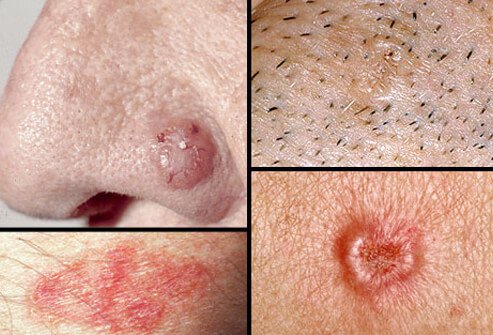The Most Frequently Occurring Form of Skin Cancer
 BCCs are abnormal, uncontrolled growths or lesions that arise in the skin’s basal cells, which line the deepest layer of the epidermis (the outermost layer of the skin). BCCs often look like open sores, red patches, pink growths, shiny bumps, or scars. Usually caused by a combination of cumulative UV exposure and intense, occasional UV exposure, BCC can be highly disfiguring if allowed to grow, but almost never spreads (metastastasizes) beyond the original tumor site. Only in exceedingly rare cases can BCC spread to other parts of the body and become life-threatening.
BCCs are abnormal, uncontrolled growths or lesions that arise in the skin’s basal cells, which line the deepest layer of the epidermis (the outermost layer of the skin). BCCs often look like open sores, red patches, pink growths, shiny bumps, or scars. Usually caused by a combination of cumulative UV exposure and intense, occasional UV exposure, BCC can be highly disfiguring if allowed to grow, but almost never spreads (metastastasizes) beyond the original tumor site. Only in exceedingly rare cases can BCC spread to other parts of the body and become life-threatening.
There are an estimated 2.8 million cases of BCC diagnosed in the US each year. In fact, it is the most frequently occurring form of all cancers. More than one out of every three new cancers are skin cancers, and the vast majority are BCCs. It shouldn’t be taken lightly: this skin cancer can be disfiguring if not treated promptly. Are you at risk? We have the information you need about the prevention, detection, and treatment of basal cell carcinoma.
The Five Warning Signs of Basal Cell Carcinoma
Frequently, two or more of these features are present in one tumor. In addition, BCC sometimes resembles noncancerous skin conditions such as psoriasis or eczema. Only a trained physician, such as a specialist in diseases of the skin, can decide for sure. If you observe any of the warning signs or some other worrisome change in your skin, consult your physician immediately.
Not to Be Ignored
BCCs are easily treated in their early stages. The larger the tumor has grown, however, the more extensive the treatment needed. Although this skin cancer seldom spreads, or metastasizes, to vital organs, it can damage surrounding tissue, sometimes causing considerable destruction and disfigurement – and some BCCs are more aggressive than others. When small skin cancers are removed, the scars are usually cosmetically acceptable. If the tumors are very large, a skin graft or flap may be used to repair the wound in order to achieve the best cosmetic result and facilitate healing.
Causes and Risk Factors
The Major Cause Almost all BCCs occur on parts of the body excessively exposed to the sun – especially the face, ears, neck, scalp, shoulders, and back. On rare occasions, however, tumors develop on unexposed areas. In a few cases, contact with arsenic, exposure to radiation, open sores that resist healing, chronic inflammatory skin conditions, and complications of burns, scars, infections, vaccinations, or even tattoos are contributing factors.
Who Gets It?
Anyone with a history of sun exposure can develop BCC. However, people who are at highest risk have fair skin, blond or red hair, and blue, green, or grey eyes. Those most often affected are older people, but as the number of new cases has increased sharply each year in the last few decades, the average age of patients at onset has steadily decreased. The disease is rarely seen in children, but occasionally a teenager is affected. Dermatologists report that more and more people in their twenties and thirties are being treated for this skin cancer.
Men with BCC have outnumbered women with the disease, but more women are getting BCCs than in the past. Workers in occupations that require long hours outdoors and people who spend their leisure time in the sun are particularly susceptible.
Risk of Recurrence
People who have had one BCC are at risk for developing others over the years, either in the same area or elsewhere on the body. Therefore, regular visits to a dermatologist should be routine so that not only the site(s) previously treated, but the entire skin surface can be examined. BCCs on the scalp and nose are especially troublesome, with recurrences typically taking place within the first two years following surgery. Should a cancer recur, the physician might recommend a different type of treatment. Some methods, such as Mohs micrographic surgery, may be highly effective for recurrences.
Treatment Options
After the physician’s examination, the diagnosis of BCC is confirmed with a biopsy. In this procedure, the skin is first numbed with local anesthesia. A piece of tissue is then removed and sent to be examined under a microscope in the laboratory to seek a definitive diagnosis. If tumor cells are present, treatment is required. Fortunately, there are several effective methods for eradicating BCC. Choice of treatment is based on the type, size, location, and depth of penetration of the tumor, the patient’s age and general health, and the likely cosmetic outcome of specific treatments.
Treatment can almost always be performed on an outpatient basis in the physician’s office or at a clinic. With the various surgical techniques, a local anesthetic is commonly used. Pain or discomfort during the procedure is minimal, and pain afterwards is rare.
Mohs Micrographic Surgery
Using local anesthesia, the physician removes the tumor with a very thin layer of tissue around it. The layer is immediately checked under a microscope thoroughly. If tumor is still present in the depths or peripheries of this surrounding tissue, the procedure is repeated until the last layer examined under the microscope is tumor-free. This technique saves the greatest amount of healthy tissue and has the highest cure rate, generally 98 percent or better. It is frequently used for tumors that have recurred, are poorly demarcated, or are in critical areas around the eyes, nose, lips, and ears. After removal of the skin cancer, the wound may be allowed to heal naturally or be reconstructed using plastic surgery methods.
Excisional Surgery
After numbing the area with local anesthesia, the physician uses a scalpel to remove the entire growth along with a surrounding border of normal skin as a safety margin. The skin around the surgical site is then closed with a number of stitches, and the excised tissue is sent to the laboratory for microscopic examination to verify that all the malignant cells have been removed. The effectiveness of the technique does not match that of Mohs, but produces cure rates around 90 percent.
Curettage and Electrodesiccation
Using local anesthesia, the physician scrapes off the cancerous growth with a curette (a sharp, ring-shaped instrument). The heat produced by an electrocautery needle destroys residual tumor and controls bleeding. This technique may be repeated twice or more to ensure that all cancer cells are eliminated. It can produce cure rates approaching those of surgical excision, but may not be as useful for aggressive BCCs or those in high-risk or difficult sites.
Radiation
X—ray beams are directed at the tumor, with no need for cutting or anesthesia. Total destruction generally requires several treatments per week for a few weeks. Radiation may be used for tumors that are hard to manage surgically and for elderly patients or others who are in poor health. Cure rates are around 90 percent, but the technique can involve long-term cosmetic problems and radiation risks, as well as multiple visits. No anesthesia is necessary.
Cryosurgery
Tumor tissue is destroyed by freezing with liquid nitrogen, without the need for cutting or anesthesia. The procedure may be repeated at the same session to ensure total destruction of malignant cells. The growth becomes crusted and scabbed, and usually falls off within weeks. Cryosurgery is effective for the most common tumors and is the treatment of choice for patients with bleeding disorders or an intolerance to anesthesia. This method is used less commonly today, and has a lower cure rate than the surgical techniques—approximately 85-90 percent depending on the physician’s expertise.
Photodynamic Therapy (PDT)
PDT can be useful when patients have multiple BCCs. A photosensitizing agent such as Topical 5-aminolevulinic acid (5-ALA) is applied to the tumors at the physician’s office. It is taken up by the abnormal cells. The next day, the patient returns, and those medicated areas are activated by a strong light. This treatment selectively destroys BCCs while causing minimal damage to surrounding normal tissue. PDT is FDA approved for treatment of superficial and nodular BCCs. Cure rates can vary considerably, ranging from 70 to 90 percent. Patients become photosensitive for 48 hours after the treatment and must stay out of the sun.
Laser Surgery
The skin’s outer layer and variable amounts of deeper skin are removed using a carbon dioxide or erbium YAG laser. Lasers give the doctor good control over the depth of tissue removed, and are sometimes used as a secondary therapy when other techniques are unsuccessful. Laser treatment has recurrence rates similar to those of PDT. It is not FDA-approved for BCC.
Topical Medications
Imiquimod is FDA-approved only for superficial BCCs, with cure rates generally between 80 and 90 percent. The 5% cream is rubbed gently into the tumor five times a week for up to six weeks or longer. It is the first in a new class of drugs that work by stimulating the immune system.
5-Fluorouracil (5-FU) also has been FDA-approved for superficial BCCs, with similar cure rates to imiquimod. The 5% liquid or ointment is gently rubbed into the tumor twice a day for three to six weeks.
Trials with more invasive BCCs are under way for both imiquimod and 5-FU. Side effects are variable, and some patients do not experience any discomfort, but redness, irritation, and inflammation are predictable.
New Medicine for Advanced Basal Cell Carcinoma
In extraordinarily rare cases of metastatic BCC or locally advanced BCC, this cancer can become dangerous, sometimes even life-threatening. ErivedgeTM (vismodegib), the first medicine ever for advanced BCC, is an oral drug approved by the FDA in early 2012 only for very limited circumstances where the nature of the cancer precludes other treatment options (such as surgery or radiation). Due to a risk of birth defects, vismodegib should not be used by women who are pregnant or attempting to conceive.
Prevention Guidelines
While BCCs and other skin cancers are almost always curable when detected and treated early, it is best to prevent them in the first place. Make these sun safety habits part of your daily health care routine:
- Seek the shade, especially between 10 AM and 4 PM.
- Do not burn.
- Avoid tanning and UV tanning booths.
- Cover up with clothing, including a broad-brimmed hat and UV-blocking sunglasses.
- Use a broad spectrum (UVA/UVB) sunscreen with an SPF of 15 or higher every day. For extended outdoor activity, use a water-resistant, broad spectrum (UVA/UVB) sunscreen with an SPF of 30 or higher.
- Apply 1 ounce (2 tablespoons) of sunscreen to your entire body 30 minutes before going outside. Reapply every two hours or after swimming or excessive sweating.
- Keep newborns out of the sun. Sunscreens should be used on babies over the age of six months.
- Examine your skin head-to-toe every month.
- See your doctor every year for a professional skin exam.

